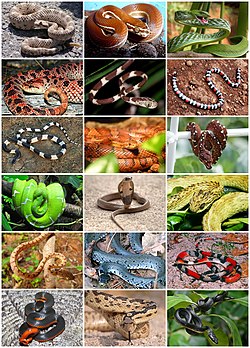
Back Slang AF Schlangen ALS እባብ AM Serpentes AN Snaca ANG सर्प ANP ثعبان Arabic ܚܘܝܐ ARC تعبان ARZ সাপ AS
| Snakes | |
|---|---|
| Scientific classification | |
| Domain: | Eukaryota |
| Kingdom: | Animalia |
| Phylum: | Chordata |
| Class: | Reptilia |
| Order: | Squamata |
| Clade: | Ophidia |
| Suborder: | Serpentes Linnaeus, 1758 |
| Infraorders | |
| |

| |
| Approximate world distribution of snakes, all species | |
Snakes are elongated, limbless, carnivorous reptiles of the suborder Serpentes (/sɜːrˈpɛntiːz/).[2] Like all other squamates, snakes are ectothermic, amniote vertebrates covered in overlapping scales. Many species of snakes have skulls with several more joints than their lizard ancestors, enabling them to swallow prey much larger than their heads (cranial kinesis). To accommodate their narrow bodies, snakes' paired organs (such as kidneys) appear one in front of the other instead of side by side, and most have only one functional lung. Some species retain a pelvic girdle with a pair of vestigial claws on either side of the cloaca. Lizards have independently evolved elongate bodies without limbs or with greatly reduced limbs at least twenty-five times via convergent evolution, leading to many lineages of legless lizards.[3] These resemble snakes, but several common groups of legless lizards have eyelids and external ears, which snakes lack, although this rule is not universal (see Amphisbaenia, Dibamidae, and Pygopodidae).
Living snakes are found on every continent except Antarctica, and on most smaller land masses; exceptions include some large islands, such as Ireland, Iceland, Greenland, the Hawaiian archipelago, and the islands of New Zealand, as well as many small islands of the Atlantic and central Pacific oceans.[4] Additionally, sea snakes are widespread throughout the Indian and Pacific oceans. Around thirty families are currently recognized, comprising about 520 genera and about 3,900 species.[5] They range in size from the tiny, 10.4 cm-long (4.1 in) Barbados threadsnake[6] to the reticulated python of 6.95 meters (22.8 ft) in length.[7] The fossil species Titanoboa cerrejonensis was 12.8 meters (42 ft) long.[8] Snakes are thought to have evolved from either burrowing or aquatic lizards, perhaps during the Jurassic period, with the earliest known fossils dating to between 143 and 167 Ma ago.[9][10] The diversity of modern snakes appeared during the Paleocene epoch (c. 66 to 56 Ma ago, after the Cretaceous–Paleogene extinction event). The oldest preserved descriptions of snakes can be found in the Brooklyn Papyrus.
Most species of snake are nonvenomous and those that have venom use it primarily to kill and subdue prey rather than for self-defense. Some possess venom that is potent enough to cause painful injury or death to humans. Nonvenomous snakes either swallow prey alive or kill by constriction.
- ^ Cite error: The named reference
snake_origin_ecologywas invoked but never defined (see the help page). - ^ Reeder TW, Townsend TM, Mulcahy DG, Noonan BP, Wood PL, Sites JW, Wiens JJ (2015). "Integrated analyses resolve conflicts over squamate reptile phylogeny and reveal unexpected placements for fossil taxa". PLOS ONE. 10 (3): e0118199. Bibcode:2015PLoSO..1018199R. doi:10.1371/journal.pone.0118199. PMC 4372529. PMID 25803280.
- ^ Wiens JJ, Brandley MC, Reeder TW (January 2006). "Why does a trait evolve multiple times within a clade? Repeated evolution of snakelike body form in squamate reptiles" (PDF). Evolution; International Journal of Organic Evolution. 60 (1): 123–41. doi:10.1554/05-328.1. PMID 16568638. S2CID 17688691. Archived (PDF) from the original on 2 February 2023. Retrieved 21 January 2023.
- ^ Bauchot, Roland, ed. (1994). Snakes: A Natural History. New York: Sterling Publishing Co., Inc. p. 220. ISBN 978-1-4027-3181-5.
- ^ "Search results for Higher taxa: snake". reptile-database.org. Archived from the original on 11 April 2021. Retrieved 7 March 2021.
- ^ Cite error: The named reference
zootaxawas invoked but never defined (see the help page). - ^ Fredriksson, G. M. (2005). "Predation on Sun Bears by Reticulated Python in East Kalimantan, Indonesian Borneo". Raffles Bulletin of Zoology. 53 (1): 165–168. Archived from the original on 9 July 2014.
- ^ Cite error: The named reference
headwas invoked but never defined (see the help page). - ^ Perkins S (27 January 2015). "Fossils of oldest known snakes unearthed". news.sciencemag.org. Archived from the original on 30 January 2015. Retrieved 29 January 2015.
- ^ Caldwell MW, Nydam RL, Palci A, Apesteguía S (January 2015). "The oldest known snakes from the Middle Jurassic-Lower Cretaceous provide insights on snake evolution". Nature Communications. 6 (5996): 5996. Bibcode:2015NatCo...6.5996C. doi:10.1038/ncomms6996. hdl:11336/37995. PMID 25625704.
